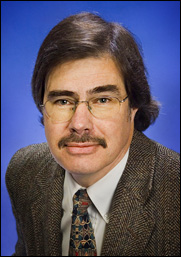Brookhaven Lab Physicist John Tranquada Receives 2006 Prize From the Neutron Scattering Society of America
June 6, 2006
UPTON, NY - The Neutron Scattering Society of America has named John Tranquada, a senior physicist at the U.S. Department of Energy's Brookhaven National Laboratory, the recipient of its 2006 Sustained Research Prize. The $2,500 prize recognizes a sustained contribution to science using neutron scattering techniques. In these techniques, scientists use neutrons, subatomic particles created in a nuclear reactor or a particle accelerator, to probe materials for insight into their atomic structure and dynamics.
Tranquada was recognized for "his outstanding neutron scattering studies of the charge and spin ordering in the high-temperature cuprates and related materials." He will be given the award at the American Conference on Neutron Scattering in St Charles, Illinois, on June 21.
"I am honored to receive this award," Tranquada said. " I joined Brookhaven's Physics Department at an exciting time, in 1986, the year that the first high-temperature superconductor was discovered. I am gratified that, with my colleagues, I have been able to elucidate some of the surprising properties of these materials. As often happens in basic research, our results raise as many questions as they answer."
Most superconductors - materials with no electrical resistance - have to be cooled to almost absolute zero (minus 459.67 degrees F) before becoming superconducting. But copper-oxide compounds, called cuprates, show superconducting properties at the relatively high temperature of minus 220 degrees F. If they can be made to be economical, superconductors could be used widely for power transmission and applications in the electronics industry.
Based on his neutron-scattering experiments in the 1980s at Brookhaven's High Flux Beam Reactor, Tranquada discovered that cuprates exhibit antiferromagnetism, a condition in which adjacent magnetic atoms have their magnetic north poles pointing in opposite directions.
In the 1990s, Tranquada and his colleagues discovered that high-temperature superconductors have a tendency toward charge segregation, which enables the coexistence of conducting and insulating properties. This work indicates that the electronic structure of high-temperature superconductors consists of fluctuating strings of charge, known as stripes, a concept that is increasingly influencing the current models of high-temperature superconductors.
John Tranquada received a B.A. in physics from Pomona College in 1977 and a Ph.D. in physics from the University of Washington in 1983. He did postodoctoral research at Brookhaven's National Synchrotron Light Source from 1983 to 1986, officially joining Brookhaven as an assistant physicist in 1986. He worked his way through the ranks to become leader of Brookhaven's Neutron Scattering Group in 1998, and senior physicist in 2000.
A Fellow of the American Physical Society, Tranquada received a U.S. Department of Energy Award for Outstanding Scientific Accomplishment in Solid State Physics in 1988, and he was honored with Brookhaven Lab's Research & Development Award in 1997.
2006-10500 | INT/EXT | Newsroom










